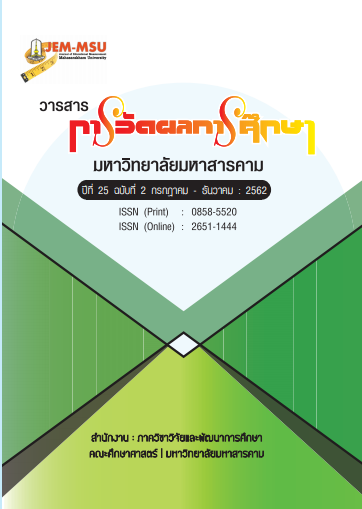The Development of Basic Personality Scales for upper Secondary School Students
Main Article Content
Abstract
The objectives of this study were: 1) to develop basic personality scales for upper secondary education students; 2) to examine structural validity of the basic personality scales that have been developed with the empirical data for upper secondary education students; and 3) to try out the basic personality scales that have been developed for upper secondary education students. The sample consisted of 600 upper secondary education students, obtained through multi-stage random sampling, and a second order confirmatory factor analysis was employed in the data analysis.
The research findings were:
1. The basic personality scales for upper secondary education students consisted of five personality factors: neuroticism, extraversion, openness to experience, agreeableness, and conscientiousness, with a total of 178 items. All items had the I-CVI over .80; the item-to-scale correlations ranged from .20 to .71; and the total reliability was .98.
2. The basic personality scales that had been developed were consistent with the empirical data, having χ2 = 535.67, df = 271, relative chi-square = 1.98, RMR = .02, NFI = .90, TLI = .92, and GFI = .94. The extraversion had the highest factor loading (1.00), followed by the factor loadings of neuroticism, agreeableness, openness to experience, and conscientiousness which had the values of .98, .85, .82, and .60 respectively.
3. The basic personality scales for upper-secondary education students that had been developed and the NEO™ Personality Inventory-3 were significantly correlated at the .01 level.
Article Details
The content and information contained in the published article in the Journal of Educational Measurement Mahasarakham University represent the opinions and responsibilities of the authors directly. The editorial board of the journal is not necessarily in agreement with or responsible for any of the content.
The articles, data, content, images, etc. that have been published in the Journal of Educational Measurement Mahasarakham University are copyrighted by the journal. If any individual or organization wishes to reproduce or perform any actions involving the entirety or any part of the content, they must obtain written permission from the Journal of Educational Measurement Mahasarakham University.
References
พูลพงศ์ สุขสว่าง. (2557). หลักการวิเคราะห์โมเดลสมการโครงสร้าง. วารสารมหาวิทยาลัยนราธิวาสราชนครินทร์ 6(2), 136-145.
Ashton, M. C., & Lee, K. (2009). The HEXACO–60: A short measure of the major dimensions of personality. Journal of Personality Assessment, 91(4), 340-345.
Anderson, C., Spataro, S. E., & Flynn, F. J. (2008). Personality and organizational culture as determinants of influence. Journal of Applied Psychology, 93(3), 702-710.
Bayram, S., Deniz, L., & Erdogan, Y. (2008). The Role of Personality Traits in Web Based Education. Turkish Online Journal of Educational Technology-TOJET, 7(2), 41-50.
Clark, M. H., & Schroth, C. A. (2010). Examining relationships between academic motivation and personality among college students. Learning and Individual Differences, 20(1), 19-24.
Costa, P. T., & McCrae, R. R. (1992). NEO PI-R Professional Manual. Odessa: Psychological Assessment Resources.
Dahmann, S., & Anger, S. (2014). The Impact of Education on Personality: Evidence from a German High School Reform. IZA Discussion Papers 8139, Institute for the Study of Labor (IZA).
Dawis, R. V., & Lofquist, L. H. (1976). Personality style and the process of work adjustment. Journal of Counseling Psychology, 23(1), 55-59.
Hair Jr., J. F., Black, W. C., Babin, B. J., & Anderson, R. E. (2014). Multivariate data analysis: A global perspective. 7th ed. London: Pearson.
Judge, T. A., Klinger, R., Simon, L. S., & Yang, I. W. F. (2008). The contributions of personality to organizational behavior and psychology: Findings, criticisms, and future research directions. Social and Personality Psychology Compass, 2(5), 1982-2000.
Komarraju, M., & Karau, S. J. (2005). The relationship between the big five personality traits and academic motivation. Personality and individual differences, 39(3), 557-567.
Komarraju, M., Karau, S. J., Schmeck, R. R., & Avdic, A. (2011). The Big Five personality traits, learning styles, and academic achievement. Personality and Individual Differences, 51(4), 472 – 477.
LoBiondo-Wood, G., & Haber, J. (2014). Nursing research: Methods and critical appraisal for evidence-based practice. 8th ed. Missouri: Elsevier Mosby.
Maltby, J., Day, L., & Macaskill, A. (2013). An introduction to psychometric testing. In Personality, individual differences, and intelligence (pp. 631-670). London: Pearson Education.
Marsh, H. W., & Hocevar, D. (1985). Application of confirmatory factor analysis to the study of self-concept: First-and higher order factor models and their invariance across groups. Psychological bulletin, 97(3), 562–582.
Morris, B. (1953). Personality Study: Its Aims and Implications for Students of Education. The Sociological Review, 1(1), 75-86.
Polit, D. F., Beck, C. T., & Owen, S. V. (2007). Is the CVI an acceptable indicator of content validity? Appraisal and recommendations. Research in Nursing & Health, 30(4), 459-467.
Poropat, A. E. (2009). A meta-analysis of the five-factor model of personality and academic performance. Psychological Bulletin, 135(2), 322–338.
Schumacker, R. E. & Lomax, R. G. (2016). A beginner’s guide to structural equation modelling. 4th ed. New York: Taylor & Francis.
Shi, J., Mo, X., & Sun, Z. (2012). Content validity index in scale development. Journal of Central South University. Medical Sciences, 37(2), 152–155.


